Thursday, October 15th, 2020 by Julian Karsunky
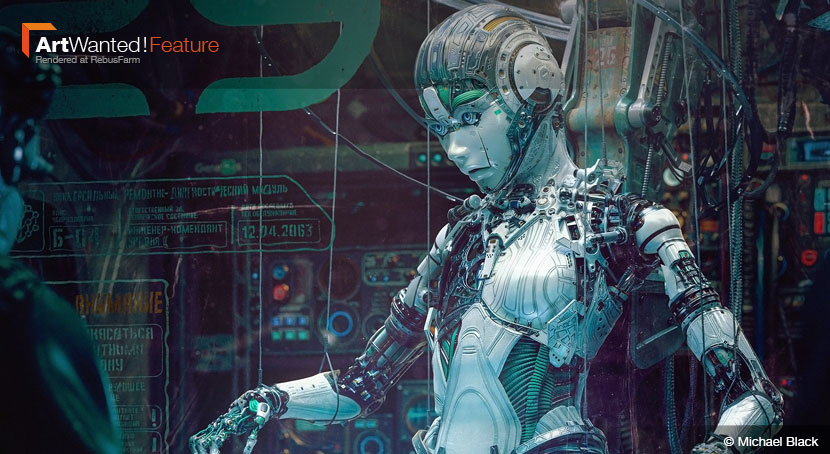
For this month’s ArtWanted! feature, we once again have the great pleasure to present to you the incredible work of Mikhail Buleyko, better known as Michael Black. In 2018, we crowned Mikhail our 3D Artist of the Year, and despite working a full-time job, he has not slowed down a bit! His latest personal project tells a powerful story of liberation through a familiar Sci-Fi lens. Consisting of staggering number of images and an innovative making-of video, ‘Sisters‘ is yet another shining example of visual story-telling and testament to Mikhail’s outstanding artistic ability.
Continue reading to find out how Mikhail skillfully weaves a compelling narrative and immerse yourself in his rich and unsettling vision of a not so distant future.
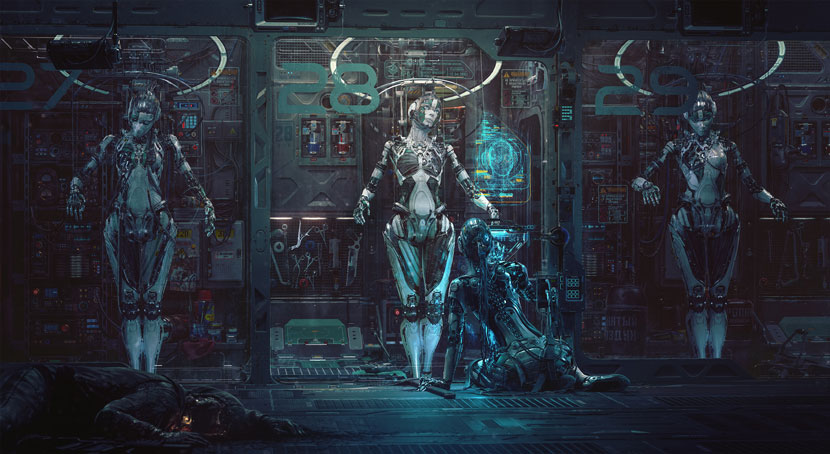 Divided into two series of images, Mikhail Buleyko’s ‘Sisters’ tells a powerful story of liberation through a familiar Sci-Fi lens.
Divided into two series of images, Mikhail Buleyko’s ‘Sisters’ tells a powerful story of liberation through a familiar Sci-Fi lens.
Hi Mikhail, thanks for joining us once again, we’re glad to have you back! For those who might have missed our first interview, please introduce yourself to our readers!
Hey there! My name is Mikhail Buleyko, although you’re more likely to find me on the internet under my pseudonym Michael Black, which is basically just an anglicization of my real name for the convenience of English-speaking audiences.
Please tell us about your current job situation! Are you still working full-time with the occasional freelance project on the side?
Yeah, I am still working as a 3D artist for a game studio in my native city of Rostov-on-Don.
I also continue to take on remote work, but I only pick projects that are not urgent and interesting to myself. My full-time job requires a lot of time and effort, but it also provides a steady income, so thankfully, I do not financially depend on freelance work.
How are you holding up in these trying times? Has the current crisis impeded your professional life?
A couple of business trips to Asia were canceled due to closed borders. Otherwise, everything is fine, business continues as usual, for the most part.
 This overhead view of model 2509 laid out on the workbench offers a detailed look at the intricate character model.
This overhead view of model 2509 laid out on the workbench offers a detailed look at the intricate character model.
Two years ago, we had an in-depth discussion of your then latest personal project ‘Rusty Skies’, an incredibly stylish and imaginative window into a dystopian future. ‘Sisters’, your newest work, once again takes us into a rather unsettling tomorrow. Can you first describe the basic concept and narrative in more detail?
It is rather difficult for me to pinpoint what this work is about, but I’ll give it a try:
The images depict a pair of outdated android models that are to be recycled and disassembled for spare parts. These androids developed some form of self-awareness, an emotional connection arose between them, and they rebelled against their fate, breaking free from outside control and ultimately confront their human masters to protect themselves and their own kind.
‘Sisters’ consists of an overwhelming number of different scenes and shots, which you divided into two sequences: ‘Broken Dolls’ and ‘Synthetic Compassion’. Was the project always planned as a series of images, or did the project take on a life on its own?
Originally, I had just planned a few shots to tell a short story and reveal the setting in more detail. However, when I started working on the project, the images naturally split into a “before” and an “after”. Going with a two-part structure therefore felt like the obvious choice.
How long did it take you to complete the project?
As this is a personal project, I had no fixed schedule, so instead I only chose to work on it dependent on my mood and my spare time available. It is hard to estimate how much time I put into ‘Sisters’ in total. Just going by the calendar, around three months passed between starting and publishing the project.
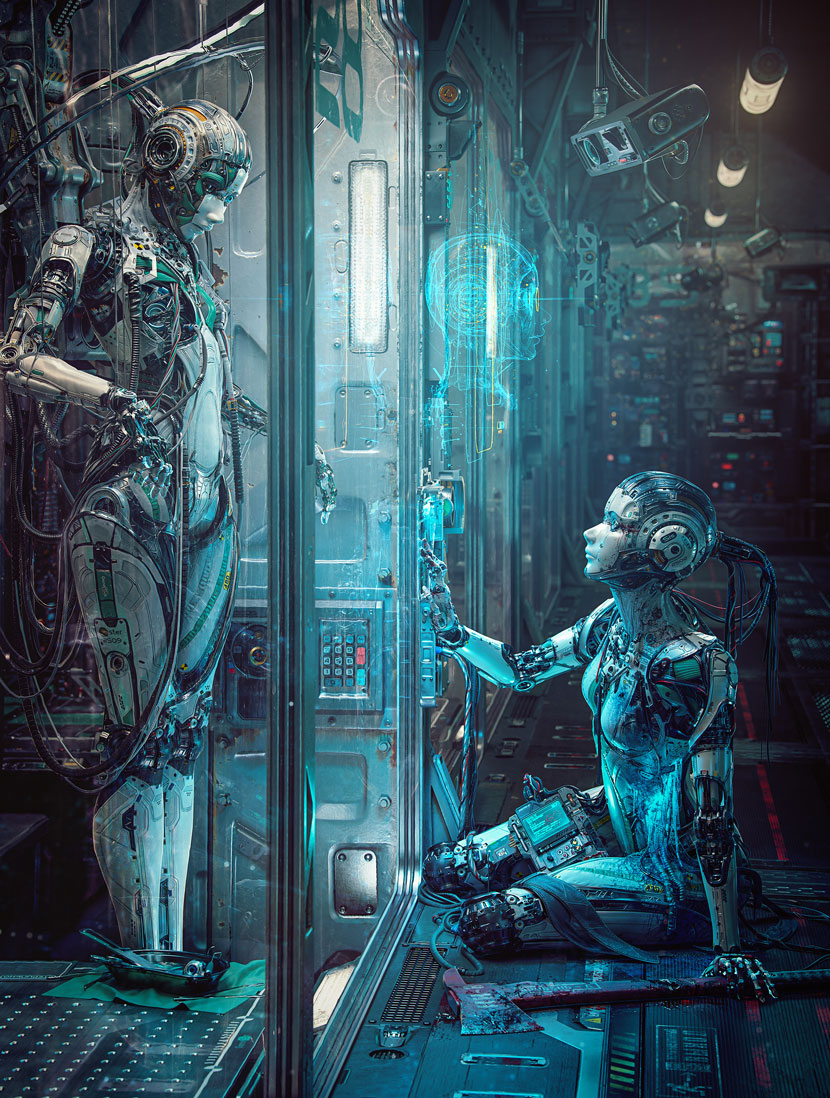 ‘Synthetic Compassion’, a serene and intimate moment in a world of cold steel, the aftermath of a revolt.
‘Synthetic Compassion’, a serene and intimate moment in a world of cold steel, the aftermath of a revolt.
What were some of the challenges you had to overcome? What parts of the images were especially important to you?
The most difficult thing was probably to make human what is not human: to create plastic masks for these robotic dolls that are attractive, relatable and capable of conveying emotions. Making all the poses feel natural was challenging as well. Also, a huge amount of effort went into lighting and texturing.
How satisfied are you with the results? What has the feedback been like so far?
Honestly, it left me with mixed feelings. While the project has received very good reviews and has become quite popular with specialized communities, I still noticed that visually and narratively complex works are significantly less accepted by a wider audience as opposed to simple and unambiguous stories. We live in a world of instant gratification; people seem less and less willing to spend time and energy to look into more nuanced plots.
Knowing your approach to world-building, I’m very curious to learn more about the narrative frame work of ‘Sisters’! What can you tell us about the setting? What world is this grimy workshop located in?
‘Sisters’ takes place in a not so distant future, in which robotics has become so widespread that android repair and maintenance workshops have become as commonplace as car repair shops are in our world.
The main conflict arises from this familiarity: androids are increasingly becoming an everyday occurrence for people, eventually acquiring the status of household appliances. But as technology advances further, they become more and more perfect – and closer to self-awareness.
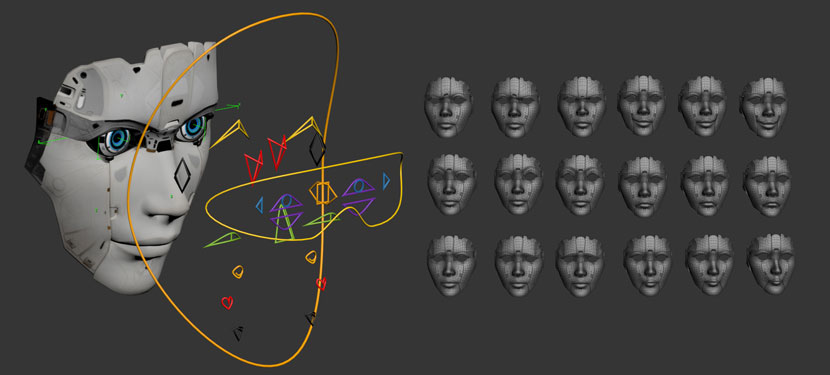 A look at the face rig Mikhail used for both human and robotic character models.
A look at the face rig Mikhail used for both human and robotic character models.
Tell us more about the “σ-dolls”! What is the “GeneSis Sisters series”? Who created all these androids and what is their purpose?
Okay, so, "GeneSis" is a transnational corporation that has the monopoly in the field of robotics and the production of androids. "Sigma-Dolls" is the commercial name for a specific chassis type, the biomechanical undercarriage for a series of versatile household robotic assistants. "Sisters" is the name of the operating system and a kind of character matrix.
The σ-doll-based "Sister" androids are an outdated, recyclable series of household robots that are slowly replaced with more modern models. In addition to their obsolescence, this series also had a manufacturing defect. These androids were supposed to exert a strong empathy for their owners, but bugs in their operating system caused them to extend this empathy to their own kind as well. This of course conflicted with the three laws of robotics as first described by Isaac Asimov. As a result, the entire series was decommissioned. To identify the causes of the operating failure, research was conducted, after which the models were to be dismantled.
This was approximately my narrative framework, from which I started building the plot.
Sisters’ evokes some of the classic Sci-Fi tropes of a robotic uprising and the ethical issues associated with artificial intelligence. Is it safe to assume the world depicted here is meant to be dystopian in that regard? Should we consider the story as a warning?
In part, yes - this is a warning. But I am not generally an opponent of progress. For me, developing robotics and artificial intelligence is a natural step in the evolution of technology. It definitely brings major changes and potential technical disasters, but then again, so did the steam engine, electricity, and nuclear energy...Ultimately, if we get used to the changes and learn how to prevent accidents, there is the potential to improve our lives significantly.
Speaking strictly from a narrative standpoint, however, the androids are merely an artistic tool. To me, this is also a story about the struggle for rights and freedom. Freeing a puppet from its strings is a powerful motive. This is directly reflected in the design of the androids as well: they appear more like puppets, or dolls, than futuristic biomechanical devices.
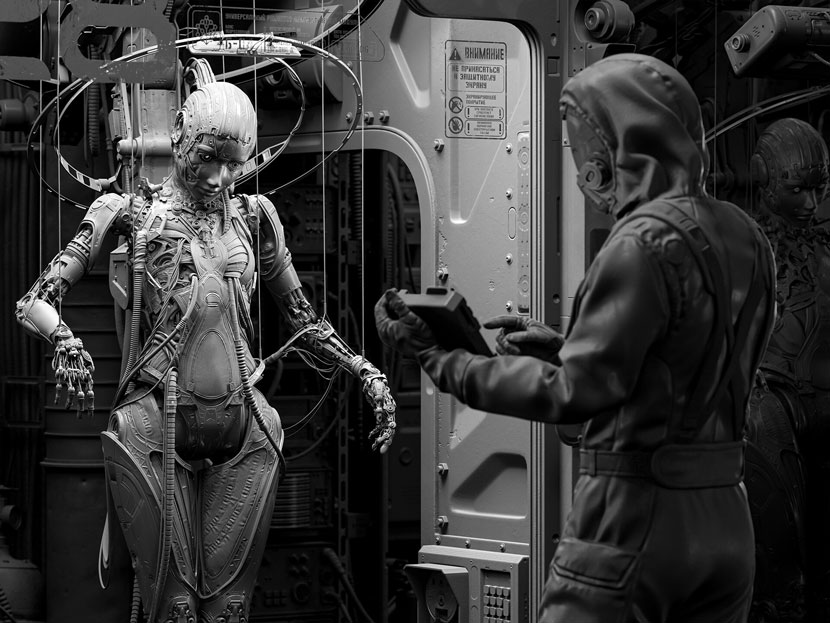 A puppet on a string: this grayscale render highlights a powerful visual motive central to the story.
A puppet on a string: this grayscale render highlights a powerful visual motive central to the story.
Tell us more about how you approach the design of the dolls!
In trying to achieve this puppet-like look, I deliberately avoided common design features such as endoskeletons, synthetic muscles and bio-membranes. Instead, I deliberately used swivel joints and hydraulic actuators to make the dolls more mechanical in appearance. This also made for a more fragile and insecure look; features that were more integral to the story than flashy or fashionable design choices.
As you mentioned before, for the purpose of the story, it was crucial to make the dolls capable of conveying emotion. How did you achieve this?
It was a rather difficult task and a challenge for me. A certain amount of stylization was definitely needed to avoid the "uncanny valley" effect. I used the same technique – a face rig with blend shapes – when working on the facial expressions, no matter if it was for a human or robotic character.
The engineers, in contrast, appear less human in their surgical masks and aprons. To me, they seem more like torturers than life-savers…
Yes, that's right, though I didn't want to antagonize them, exactly. They act as a rather impersonal elemental force, an obstacle, which the sisters need to overcome on their way to salvation and liberation.
I’m once again awed by the attention to detail that went into fleshing out this world you created. Repeatedly, I found myself fully immersed in these images, zooming in, looking for subtle intricacies…
Is this form of visual story-telling something you think a lot about and carefully plan out in detail or does it just come to you naturally?
To me, it’s a rather natural process. I'm not purposely planning everything out in advance, I'm just filling in the gaps in the story.
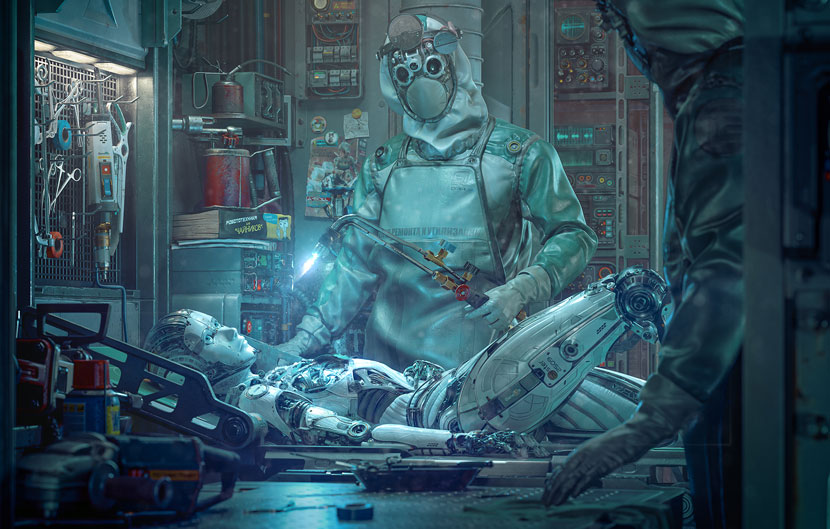 Role reversal: as the engineer is about to take a blowtorch to the robot, Sis 2509 is the one to appear human.
Role reversal: as the engineer is about to take a blowtorch to the robot, Sis 2509 is the one to appear human.
I noticed a poster in the workshop depicting someone that bears a striking resemblance to the sentinel from ‘Rusty Skies’. Is there a link here or is it more of a cameo? What does the text say?
Actually, this is a character from a different work of mine, titled ‘Kometa’. While it obviously serves as a reference, there is a thematical tie-in as well: ‘Kometa’ can be considered a positive depiction of this future, whereas ‘Sisters’ highlights the darker side of the same coin.
The make-up of the poster is done in the style of a cover from ‘Technology of Youth’, a popular Soviet periodical from my childhood. Each issue of this magazine featured a stunning hand-drawn futuristic cover illustration. I now understand that these covers had a strong influence on my style, so this is my way of paying homage.
The caption reads: "Visible outlines of the future: Delta-doll series androids guard law and order.", a visual hint that the sigma-dolls have been replaced by a newer model.
Can you point us in the direction of other such details we might miss otherwise?
I don’t know, I’d like to think everyone sees what matters to them, and misses what does not!
What software did you use to create ‘Sisters’? Any plug-ins you found particularly helpful?
I used 3ds Max and ZBrush for modeling, 3DCoat for texturing, V-Ray for rendering and Photoshop for images postprocessing.
What is something you have learned from this project that you can share with us?
For a complex project like this, the key to faster and more consistent results lies in careful planning and prep work. Draw a lot of sketches and really think the story through, before you attempt to tell it!
More than a conventional making-of, the video you put together chronicling the production of ‘Sisters’ is in itself an original piece of art.
Why did you choose this form and when did the idea first emerge?
The idea to share the creation process arose while working on the scene. I started thinking about how I wanted to do it and came across this amazing piece of music. The music by itself ultimately added a lot to the imagery and went perfect with the overall visual style.
Tell us about what went into the video and the effects used in reconstructing the models and assets.
This is pixel motion technology. It redraws the missing frames between keyframes in such a strange and specific manner. I liked this effect and decided to base my video around it. I rendered several dozen frames from the modeling process, and the rest of the frames were drawn automatically using this technology.
With how much creativity, passion and effort you pour into your personal projects, have you ever considered expanding your ideas and designs towards your own animation, game or something similar?
Of course, this is on my mind. But such tasks are beyond the power of one person; I need to start looking for like-minded people!
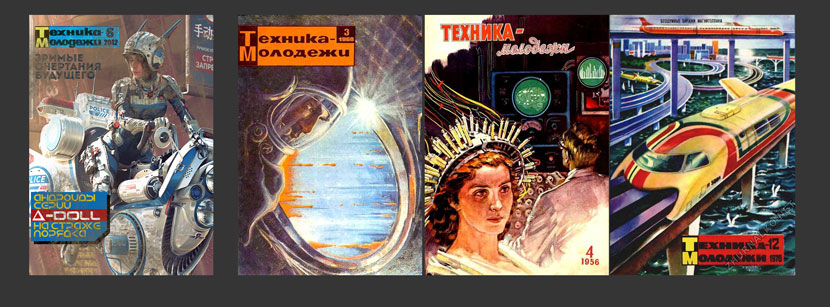 This side by side comparison shows Mikhail’s ‘Kometa’ reworked in the style of ‘Техника — молодёжи‘, an influential magazine of his childhood. The amount of effort he puts into details that might easily be missed is proof of Mikhail’s incredible dedication.
This side by side comparison shows Mikhail’s ‘Kometa’ reworked in the style of ‘Техника — молодёжи‘, an influential magazine of his childhood. The amount of effort he puts into details that might easily be missed is proof of Mikhail’s incredible dedication.
Please tell us more about your previous experience with RebusFarm. Is there anything you especially like about our service?
When working on rendering such a large series of high-resolution images, technical problems inevitably arise. But the RebusFarm support team helped me a lot in the process, providing hints and solutions on how to better prepare scenes for rendering, and how to avoid overpayments and rendering errors. It’s one of the best services I've worked with!
In closing, is there anything else you want to say? Any present or upcoming projects you’d like to mention?
Currently, I’m fully loaded with work at my job, and there is almost no time for personal projects. But I won't let that stop me! In fact, a new series of illustrations in a setting that is rather unusual for me is already in development. Stay in touch! And once again thank you for your attention to my work!
We’re happy to hear that and cannot wait to see what you come up with next! Mikhail, thank you so much for taking the time and all the best in the future!
Keep up with Mikhail Buleyko and his work here:
How to join ArtWanted!
You want to get featured in our ArtWanted! campaign and win 250 RenderPoints on top? Submit your work, rendered at RebusFarm, to Questo indirizzo email è protetto dagli spambots. È necessario abilitare JavaScript per vederlo.! Visit our Art Wanted! page for more information.
>> Read more articles on our blog
